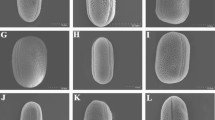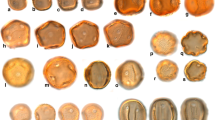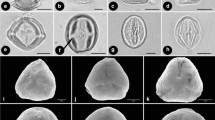Abstract
To better understand the taxonomy of Pulicaria, the pollen wall architecture of the six Iberian species were investigated using light (LM) and scanning electron microscopy (SEM). The exine structure of Pulicaria odora was also investigated using transmission electron microscopy (TEM). Statistical analysis was performed to distinguish taxonomically significant morphometric information from all the measured parameters of pollen grains. It was found that the exine sculpture characters, with special importance paid to the spines, were the most useful of all characters to define Pulicaria pollen types and separate the species. Three pollen types distinguishable through the spines morphology and the inter-spinular sculpture are described: P. microcephala pollen type (incl. P. microcephala), P. vulgaris pollen type (incl. P. vulgaris), and P. dysenterica pollen type (incl. P. dysenterica, P. odora, P. paludosa and P. sicula). A dichotomous key to these Pulicaria pollen types is proposed. The distribution of P. dysenterica, P. odora, P. paludosa and P. sicula in more than one leaf node in the classification tree reveals that the pollen grains of these species are difficult to segregate. Therefore, the construction of a satisfactory dichotomous key to the P. dysenterica pollen type species is not feasible. Yet, the different spines apex morphology between P. microcephala and P. paludosa and the existence of significant differences in five of the eight studied quantitative pollen characters of these two taxa, supports the opinion that the Berlengas Islands endemic P. microcephala should be accepted as a separate species. In addition, the differences among the spines morphology of P. vulgaris, P. microcephala, and the other four Iberian (and European) species, strengthen the conclusion that the section Pulicaria is non-monophyletic.





Similar content being viewed by others
References
Almada F, Cruz M, Gomes C, Gonçalves D, Rodrigues J (1995) Contribution to the determination of the taxonomic position of Pulicaria microcephala Lange. Bol Soc Brot Ser 2 67:43–54
Anderberg AA (1991) Taxonomy and phylogeny of the tribe Inuleae (Asteraceae). Pl Syst Evol 176:75–123
Anderberg AA (2009) Inuleae. In: Funck VA, Susanna A, Stuessy TF, Bayer RJ (eds) Systematics evolution and biogeography of compositae. Sheridan Books Inc, Ann Arbor, Michigan, pp 667–679
Anderberg AA, Eldenäs P (2007) Inuleae. In: Kadereit J, Jeffrey C (eds) Families and genera of vascular plants, flowering plants, eudicots, asterales, vol 8. Springer, Berlin, pp 374–391
Anderberg AA, Eldenäs P, Bayer RJ, Englund M (2005) Evolutionary relationships in the Asteraceae tribe Inuleae (incl. Plucheae) evidenced by DNA sequences on ndhF; with notes on the systematic positions of some aberrant genera. Org Div Evol 5:135–146
Avetisian E, Tonyan T (1975) Palynomorphology and number of chromosomes of some of the species of subtribe Centaureineae Less. (in Russian). Akad Nauk Arm SSSR 16:45–49
Blackmore S (1982) Palynology of subtribe Scorzonerinae (Compositae: Lactuceae) and its taxonomic significance. Grana 21:149–160
Bolick M (1991) Pollen diameter, exine thickness, and ultrastructure type in the tribes of the Compositae. Comp Newsl 19:17–21
Bronckers (1963) Variations polliniques dans une série d’autopolyploïdes artificiels d’ Arabidopsis thaliana (L.) Heyenh. Pollen Spores 5:233–258
Brullo S, Pavone P, Terrazi MC, Zizza A (1978) Numeri chromosomici per la Flora Italiana. Inform Botan Italiana 10:397
Daveau J (1883) Excursion Botanique aux îles Berlengas et Farilhões. Bol Soc Brot 1:13–31
De Candolle AP (1836) Pulicaria. In: Prodromus Systematis naturalis Regni vegetabilis, vol 5. Sumptibus Sociorum Treuttel et Würtz, Paris, pp 477–480
De Leonardis W, Fichera G, Longhitano N, Zizza A (1995) Palynological key to 56 taxa of the subfamily Cichorioideae (Asteraceae) present in Sicily. Bol Soc Brot Ser 2 67:151–170
Diez MJ (1987) Asteraceae (Compositae). In: Valdés B, Díez MJ, Fernández I (eds) Atlas Polinico de Andalucia Occidental. Instituto de Desarrollo Regional, Universidad de Sevilla, pp 332–357
Dimon MT (1971) Étude des types polliniques des Composées echinulées du Bassin Méditerranéen occidental. PhD thesis, Université des Sciences et Techniques du Languedoc, Montpellier
El-Ghazaly G (1993) A study of the pollen Flora of Sudan. Rev Palaeobot Palynol 76:99–345
Englund M, Pornpongrungrueng P, Gustafsson MHJ, Anderberg AA (2009) Phylogenetic relationships and generic delimitation in Inuleae subtribe Inulinae (Asteraceae) based on ITS and cpDNA sequence data. Cladistics 25:319–352
Erdtman G (1960) The acetolysis method. A revised description. Svensk Bot Tidsk 54:561–564
Faegri K, Iversen J (1975) Textbook of pollen analysis. Munskgaard, Copenhagen
Fernandes A (1987) Sur le rôle de la triploϊdie dans l’évolution chez la section Bulbocodii DC. du genre Narcissus L. Bol Soc Brot Ser 2 60:273–322
Fernandes A, França F (1977) Le genre Colchicum L. au Portugal. Bol Soc Brot Ser 2 51:5–36
Fernandes A, Queirós M (1971) Contribution à la connaissance cytotaxonomique des Spermatophyta du Portugal II. Compositae. Bol Soc Brot Ser 2 45:5–121
Francisco-Ortega J, Seon-Joo P, Santos-Guerra A, Abdelmalek B, Jansen RK (2001) Origin and evolution of the endemic Macaronesian Inuleae (Asteraceae): evidence from the internal transcribed spacers of nuclear ribosomal DNA. Biol J Linn Soc 72:77–97
Franco JA (1984) Pulicaria. In: Franco JA (ed) Nova Flora de Portugal, vol 2. Sociedade Astória Lda, Lisboa, pp 377–379
Gadella TW, Kliphuis E (1967) Chromosome numbers of flowering plants in the Netherlands II. Proc R Acad Sci Ser C 70:7–20
Gaertner J (1791) Pulicaria. In: De Fructibus et Seminibus Plantarum, vol 2. Tübingen, p 461
Goertzen LR, Cannone JJ, Gutell RR, Jansen RK (2003) ITS secondary structure derived from comparative analysis: implications for sequence alignment and phylogeny of the Asteraceae. Molec Phylogenet Evol 29:216–234
Hesse M, Halbritter H, Zetter R, Weber M, Buchner R, Frosh-Radivo A, Ulrich S (2009) Pollen Terminology–An illustrated handbook. Springer, Wien, New York
Hoffmann O (1897) Pulicaria. In: Engler A, Prantl K (eds) Die natürlichen Pflanzenfamilien, vol 4. Engelmann, Leipzig, p 205
Humphries CJ, Murray BG, Bocquet G, Vasudevan K (1978) Chromosome numbers of phanerogams from Morocco and Algeria. Bot Not 131:391–404
Jiménez ZRC (1986) Números cromossomáticos de plantas occidentales. Anal Jard Bot Madrid 43:385–399
Keselman HJ (1976) A power investigation of the Tukey multiple comparison statistic. Educ Psychol Meas 36:97–104
Leins P (1968) Versuch einer Gliederung der Inulinae und Buphtalminae nach den Pollenkorntypen. Ber Deutsch Bot Ges 81:498–504
Leins P (1971) Pollensystematische Studien an Inuleen. I. Tarchonanthinae, Plucheinae, Inulinae, Buphtalminae. Bot Jahrb 91:91–146
Lepš J, Šmilauer P (2003) Multivariate analysis of ecological data using CANOCO. Cambridge University Press, Cambridge
Lindbladh M, O’Connor R, Jacobson G L Jr (2002) Morphometric analysis of pollen grains for paleoecological studies: classification of Picea from eastern North America. Am J Bot 89:1459–1467
Martín Ciudad A (1991) Números Cromosomáticos de Plantas Vasculares Ibéricas, I. In: Castroviejo S, Valdés-Bermejo E (eds) Archivos de Flora Ibérica, Núm. 1. Fareso, S. A., Madrid, p 47
Morton JK (1977) A cytological study of the Compositae (excluding Hieracium and Taraxacum) of the British Isles. Watsonia 11:211–223
Murthy Sk (1998) Automatic construction of decision trees from data: a multi-disciplinary survey. Data Min Knowl Disc 2:345–389
Osman AK (2006) Contributions to the pollen morphology of the tribe Inuleae (subfamily Asteroideae-Compositae) in the flora of Egypt. Feddes Repert 3–4:193–206
Pavone P, Terrasi MC, Zizza A (1981) Números cromosomáticos de plantas occidentales. Anal Jard Bot Madrid 38:273–290
Pereira Coutinho AX (1939) Flora de Portugal, 2nd edn. Bertrand, Lisboa
Pereira Coutinho A, Dinis AM (2007) A contribution to the ultrastructural knowledge of the pollen exine in subtribe Inulinae (Inuleae, Asteraceae). Pl Syst Evol 269:159–170
Pereira Coutinho A, Dinis AM (2009a) A light, scanning electron and transmission electron microscopic study of pollen wall architecture in the subtribe Gnaphaliinae (Gnaphalieae, Asteraceae). Pl Syst Evol 283:79–82
Pereira Coutinho A, Dinis AM (2009b) Palynology of the genus Pulicaria Gaertn. (Asteraceae, Inuleae, Inulinae) in the Iberian Peninsula. Microsc Microanal 15(Supp 3):33–34
Pereira Coutinho A, Paiva J (2003) Palynology of the genus Galinsoga Ruíz & Pavón (Asteraceae) in Portugal. Polen 12:127–136
Punt W, Hoen HH, Blackmore S, Nilsson S, Le Thomas A (2007) Glossary of pollen and spore terminology. Rev Palaeobot Palynol 143:1–81
Rakotomalala R (2005) TANAGRA: un logiciel gratuit pour l’enseignement et la recherche. In: Actes de EGC’2005. RNTI-E-3 2:697–702
Ratcliffe D (1976) Pulicaria. In: Tutin TG, Heywood VH, Burges NA, Moore DM, Valentine DH, Walters SM, Webb DA (eds) Flora Europaea, vol 4, Plantaginaceae to Compositae (and Rubiaceae). Cambridge University Press, Cambridge, p 137
Salgado-Labouriau ML (1982) Pollen morphology of the Compositae of the Northern Andes. Pollen Spores 24:397–452
Sampaio GA (1947) Flora Portuguesa. Imprensa Moderna Lda, Porto
Skvarla JJ, Turner BL, Patel VC, Tomb AS (1977) Pollen morphology in the Compositae and in morphologically related families. In: Heywood VH, Harborne JB, Turner BL (eds) The biology and chemistry of Compositae. Academic, London, pp 141–265
Skvarla JJ, De Vore ML, Chissoe WF (2005) Lophate sculpture of Vernonieae (Compositae) pollen. Rev Palaeobot Palynol 133:51–68
Stanley RG, Linskens HF (1974) Pollen–Biology, Biochemistry. Management. Springer, Berlin, Heidelberg
Stix E (1960) Pollenmorphologische Untersuchungen an Compositen. Grana Palynol 2:41–114
Tarnavschi I, Mitroiu N (1959) Cercetari asupra morfologiei polenului compositelor din flora R. P. R. St Cerc Biol Ser Biol Veg Romin 11:213–271
Torices R, Anderberg AA (2009) Phylogenetic analysis of sexual systems in Inuleae (Asteraceae). Am J Bot 96:1011–1019
Tormo Molina R, Ubera Jiménez JL (1995) Tipos polínicos de la Tribu Cardueae en la Península Ibérica. Monografias del Jardín Botánico de Córdoba, vol 2. Tipografia Católica, S.C.A., Córdoba
Visset L (1974) Pollens de Compositae-Asteroideae observés au Microscope Électronique à Balayage. Beitr Biol Pflanzen 50:137–161
Wang L, Fu X (2005) Data Mining with Computational Intelligence. Springer, Berlin
Wortley AH, Funk VA, Robinson H, Skvarla JJ, Blackmore S (2007) A search for pollen morphological synapomorphies to classify rogue genera in Compositae (Asteraceae). Rev Palaeobot Palynol 146:169–181
Zar JH (1996) Biostatistical analysis. Prentice-Hall International Limited, London
Acknowledgments
We thank the curators of BC, BCN, COI, LISE, LISI, LISU, MA, PO and SALA for facilities in studying the herbarium vouchers. This work was supported by grants from the Fundação para a Ciência e Tecnologia (FCT), Portugal.
Author information
Authors and Affiliations
Corresponding author
Appendix
Appendix
Studied specimens
Pulicaria dysenterica (L.) Gaertn.
Portugal. Beira Litoral: Aveiro, Ílhavo, 30. VII. 1993, Armando, Serra and Loureiro s. n. (PO: 55428); Leiria, Pinhal do Urso, 12. VIII. 1976, Queirós 13777 (COI). Estremadura: Alenquer, 12. VII. 1973, A. Fernandes et al. 12714 (COI); Rio Maior, 31. VIII. 1961, Bento-Rainha 5054 (LISE: 65844).
Spain. Andalucia: Granada, Guadix, 29. VIII. 1977, E. Rico s. n. (SALA: 13380). Asturias: Oviedo, Sto del Barco, 29. VIII. 1978, E. Rico s. n. (SALA: 19318). Cantabria: Puente Viesgo, 29. VIII. 2005, M. Ladero and F. J. Glez. Iglesias s. n. (SALA: 110386).
Pulicaria microcephala Lange
Portugal. Estremadura: Berlenga, 24. VI. 1924, Mendonça s. n. (COI); idem, 30. VIII. 1955, Moersfehrt 7775 (COI); idem, Pedro and Costa 24192 (LISI); idem 30. VII. 1947, Bento-Rainha 1425 (LISE: 24664); idem, 14. VI. 1979, Vasconcellos and Fernandes, s. n. (LISI).
Pulicaria odora (L.) Rchb.
Portugal. Algarve: Lugar da Fornalha, 15. V. 1985, Moura 2766 (COI). Beira Baixa: Vila Velha de Rodão, 7. VII. 1971, Queirós 11786 (COI). Beira Litoral: Cantanhede, Portunhos, 4. V. 1997, Rosa s. n. (COI). Minho: Afife, VI. 1959, Punter 99 (LISE: 65839).
Spain. Castilla y Léon: Salamanca, El Bodón, 22. VI. 1978, E. Rico s. n. (SALA: 14229); Burgos, Valle de Mena, Aparicio et al. s. n. (SALA: 93308). Estremadura: Caceres, Cañaveral, 28. V. 1978, E. Rico s. n. (SALA: 13215). País Basco: Bizcaia, 5. VII. 1982, Aizpurú and Catalán 20988 (MA: 715909).
Pulicaria paludosa Link
Portugal. Baixo Alentejo: Santiago do Cacém, 6. VI. 1968, Teles 1234 (LISE: 66878). Beira Litoral: Aveiro, Pateira de Fermentelos, 12. IX. 1978, Marques and Pereira 901 (COI). Trás-os-Montes: Moncorvo, Macedo de Cavaleiros, 6. VII. 1976, A. Matos, Pimenta and Forte 13707 (COI).
Spain. Andalucia: Cadiz, Los Barrios, 8. VI. 1990, E. Rico; Jaén, 10. VI. 1992, S. Peñafiel s. n. (MA: 714923). Castilla La-Mancha: Ciudad Real, 8. VII. 2001, C. F. Aragón and R. García 88927 (MA: 730026). Castilla y Léon: Salamanca, Fuenteguinaldo, 13. VII. 1976, E. Rico s. n. (SALA: 9599). Estremadura: Cáceres, Hervás, R. Gonzáles and J. Sánchez s. n. (SALA: 99717).
Pulicaria sicula (L.) Moris
Portugal. Algarve: Luz, 19. V. 1991 E. del Castillo s. n. (BC: 807481).
Spain. Andalucia: Almeria, 20. X. 1962, H. Rufino 1295 (BCN: 6964). Cataluña: Gerona, Castelló d’ Ampurias, 28. VIII. 1978, Molero s. n. (BCN: 31320).
France. Corse: Suartone aux Tre Padule, 3. X. 1979, R. Deschatres s. n. (BC: 639914)
Pulicaria vulgaris Gaertner
Portugal. Trás-os-Montes, Macedo de Cavaleiros, 9. IX. 1967, Rozeira and Costa s. n. (PO: 24598); Miranda-do-Douro, Constantim, 10. IX. 1967, Rozeira and Costa s. n. (PO: 24599).
Spain. Castilla y Léon: Segovia, Aldeonte, 8. IX. 1984, T. Romero s. n. (SALA: 41954). Castilla-La Mancha: Ciudad Real, Argamasillo de Calatrava, 7. VIII. 2000, C. Martín-Blanco & C. Santamaria 89018 (MA: 730025). País Basco: Alava, Marieta, 13. IX. 1984, G. Morante (SALA: 38024).
Rights and permissions
About this article
Cite this article
Coutinho, A.P., Aguiar, C.F., Bandeira, D.S.d. et al. Comparative pollen morphology of the Iberian species of Pulicaria (Asteraceae, Inuleae, Inulinae) and its taxonomic significance. Plant Syst Evol 297, 171–183 (2011). https://doi.org/10.1007/s00606-011-0505-4
Received:
Accepted:
Published:
Issue Date:
DOI: https://doi.org/10.1007/s00606-011-0505-4




